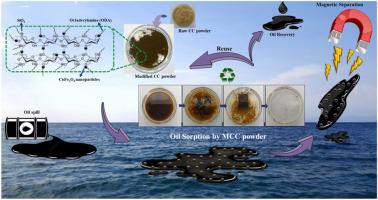Industrial Crops and Products ( IF 5.9 ) Pub Date : 2023-05-17 , DOI: 10.1016/j.indcrop.2023.116848 Fateme Rezaei , Shadi Hassanajili

|
In this study, we have demonstrated a facile method to convert corncob, an abundant and low-cost bio-waste, into a superhydrophobic magnetic bio-sorbent with potential application in oil spill remediation. We immobilized CoFe2O4 nanoparticles on the surface of corncob using the co-precipitation method to magnetize the surface of the bio-waste. Additionally, we applied silica and octadecylamine (ODA) coatings to create a rough and low surface energy sorbent material, respectively, which significantly improved its oil sorption capacity. The fabricated magnetic composite exhibited excellent magnetic responsivity (saturation magnetization: 32 emu/g), superhydrophobicity (water contact angle: 165˚), and superoleophilicity (oil contact angle: 0˚). The modified corncob (MCC) powder was easily separated using a magnetic field and showed oil sorption capacity 22.13, 13.33, 57.65, and 44.17 times its original weight for crude oils with API 23.5° and 29.7°, fresh and used motor oil, respectively. The fabricated bio-sorbent could be recovered and reused in oil-water separation at least 10 times, with a water contact angle and sorption capacity of 158.5˚ and 42 g/g, respectively, after 10 cycles. Furthermore, it displayed remarkable durability in corrosive media. We compared the performance of MCC powder with three different bio-wastes, including coconut husk, acorn, and rice husk, and found that MCC powder and coconut husk showed preferable performance over the others. Overall, our study provides a facile and efficient method for converting corncob and other bio-wastes into a superhydrophobic magnetic bio-sorbent for oil spill cleanup.
中文翻译:

用于溢油清理的超疏水磁性生物废物的简易制备
在这项研究中,我们展示了一种将玉米芯(一种丰富且低成本的生物废物)转化为超疏水磁性生物吸附剂的简便方法,该吸附剂具有潜在的溢油修复应用。我们固定了 CoFe 2 O 4玉米芯表面的纳米粒子使用共沉淀法磁化生物废物的表面。此外,我们应用二氧化硅和十八胺 (ODA) 涂层分别制成粗糙和低表面能吸附材料,显着提高了其吸油能力。制备的磁性复合材料表现出优异的磁响应性(饱和磁化强度:32emu/g)、超疏水性(水接触角:165˚)和超亲油性(油接触角:0˚)。使用磁场可以轻松分离改性玉米芯 (MCC) 粉末,对于 API 为 23.5° 和 29.7° 的原油、新鲜机油和用过的机油,其吸油能力分别是其原始重量的 22.13、13.33、57.65 和 44.17 倍。制备的生物吸附剂可回收并重复用于油水分离至少 10 次,循环 10 次后水接触角和吸附容量分别为 158.5˚ 和 42 g/g。此外,它在腐蚀性介质中表现出卓越的耐久性。我们比较了 MCC 粉末与三种不同生物废弃物(包括椰子壳、橡子和稻壳)的性能,发现 MCC 粉末和椰子壳表现出优于其他材料的性能。总体而言,我们的研究提供了一种简便有效的方法,可将玉米芯和其他生物废物转化为超疏水磁性生物吸附剂,用于溢油清理。我们比较了 MCC 粉末与三种不同生物废弃物(包括椰子壳、橡子和稻壳)的性能,发现 MCC 粉末和椰子壳表现出优于其他材料的性能。总体而言,我们的研究提供了一种简便有效的方法,可将玉米芯和其他生物废物转化为超疏水磁性生物吸附剂,用于溢油清理。我们比较了 MCC 粉末与三种不同生物废弃物(包括椰子壳、橡子和稻壳)的性能,发现 MCC 粉末和椰子壳表现出优于其他材料的性能。总体而言,我们的研究提供了一种简便有效的方法,可将玉米芯和其他生物废物转化为超疏水磁性生物吸附剂,用于溢油清理。



























 京公网安备 11010802027423号
京公网安备 11010802027423号